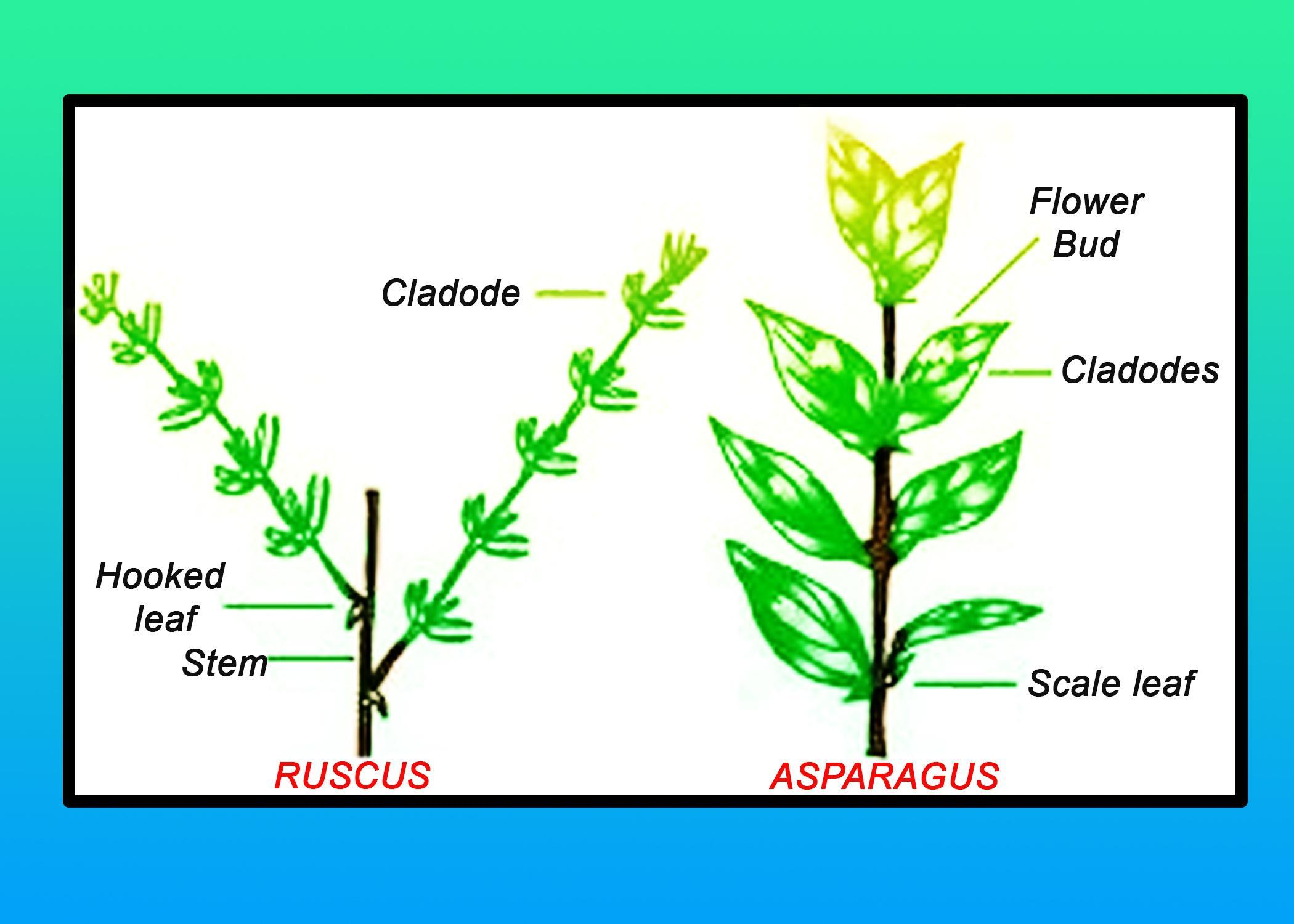
Asparagus is a
(a) Phyllode
(b) Phylloclade
(c) Cladode
(d) Branch
Answer
482.1k+ views
Hint: The plant is tall with scale-like leaves emerging from the underground stem (rhizome) and has stout stems and feathery foliage. The flowers are bell-shaped and it occurs alone or in pairs. Its young shoots are mainly used as a spring vegetable.
Complete answer:
Asparagus species are erect or climbing, and most of the species are more or less woody. The rhizome-like, or sometimes tuberous, roots give rise to conspicuous fernlike branchlets. True leaves are reduced to small scales. Many species are dioecious (individuals are either male or female), and the small greenish-yellow flowers in the spring are followed by red berries in the fall. Members of the genus are characterized by the presence of cladodes, which are leaf-like organs in the axils of the true leaves. Cladode is a modified stem. In this, branches have limited growth. They become green and flat-like leaves. It is a morphological feature of Asparagus.

So, the correct answer is ‘Cladode’.
Additional information: Asparagus has low calories but boasts an impressive nutrient profile. Asparagus also possesses small amounts of other micronutrients, including iron, zinc, and riboflavin. Asparagus is like other green vegetables, which are high in antioxidants. These include Vitamin E, Vitamin C, and glutathione, as well as various flavonoids and polyphenols. Asparagus is particularly high in insoluble fiber, which adds bulk to stool and supports regular bowel movements. It also contains a small amount of soluble fiber, which dissolves in water and forms a gel-like substance in the digestive tract.
Note: Asparagus grows best in regions with hot days and cool nights and requires 90–150 days of cold temperature to break dormancy. It will grow in most soils as long as they are well-draining and will grow optimally at a pH between 6.5 and 7.0. It should be planted in a sunny location in the home garden and it is best to avoid low lying areas as a late frost will cause damage to newly emerged spears.
Complete answer:
Asparagus species are erect or climbing, and most of the species are more or less woody. The rhizome-like, or sometimes tuberous, roots give rise to conspicuous fernlike branchlets. True leaves are reduced to small scales. Many species are dioecious (individuals are either male or female), and the small greenish-yellow flowers in the spring are followed by red berries in the fall. Members of the genus are characterized by the presence of cladodes, which are leaf-like organs in the axils of the true leaves. Cladode is a modified stem. In this, branches have limited growth. They become green and flat-like leaves. It is a morphological feature of Asparagus.

So, the correct answer is ‘Cladode’.
Additional information: Asparagus has low calories but boasts an impressive nutrient profile. Asparagus also possesses small amounts of other micronutrients, including iron, zinc, and riboflavin. Asparagus is like other green vegetables, which are high in antioxidants. These include Vitamin E, Vitamin C, and glutathione, as well as various flavonoids and polyphenols. Asparagus is particularly high in insoluble fiber, which adds bulk to stool and supports regular bowel movements. It also contains a small amount of soluble fiber, which dissolves in water and forms a gel-like substance in the digestive tract.
Note: Asparagus grows best in regions with hot days and cool nights and requires 90–150 days of cold temperature to break dormancy. It will grow in most soils as long as they are well-draining and will grow optimally at a pH between 6.5 and 7.0. It should be planted in a sunny location in the home garden and it is best to avoid low lying areas as a late frost will cause damage to newly emerged spears.
Latest Vedantu courses for you
Grade 9 | CBSE | SCHOOL | English
Vedantu 9 CBSE Pro Course - (2025-26)
School Full course for CBSE students
₹37,300 per year
Recently Updated Pages
Master Class 11 Economics: Engaging Questions & Answers for Success

Master Class 11 Business Studies: Engaging Questions & Answers for Success

Master Class 11 Accountancy: Engaging Questions & Answers for Success

Master Class 11 English: Engaging Questions & Answers for Success

Master Class 11 Computer Science: Engaging Questions & Answers for Success

Master Class 11 Maths: Engaging Questions & Answers for Success

Trending doubts
State and prove Bernoullis theorem class 11 physics CBSE

1 ton equals to A 100 kg B 1000 kg C 10 kg D 10000 class 11 physics CBSE

State the laws of reflection of light

One Metric ton is equal to kg A 10000 B 1000 C 100 class 11 physics CBSE

1 Quintal is equal to a 110 kg b 10 kg c 100kg d 1000 class 11 physics CBSE

Difference Between Prokaryotic Cells and Eukaryotic Cells




